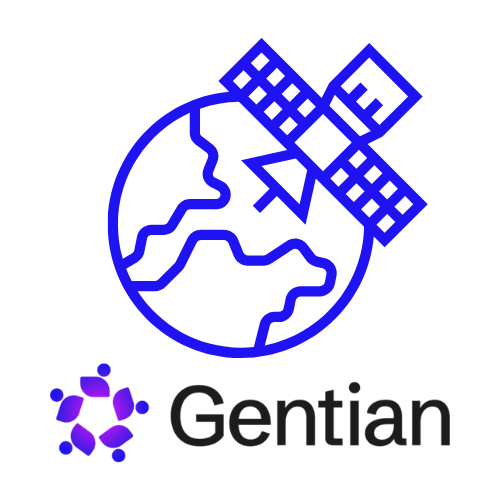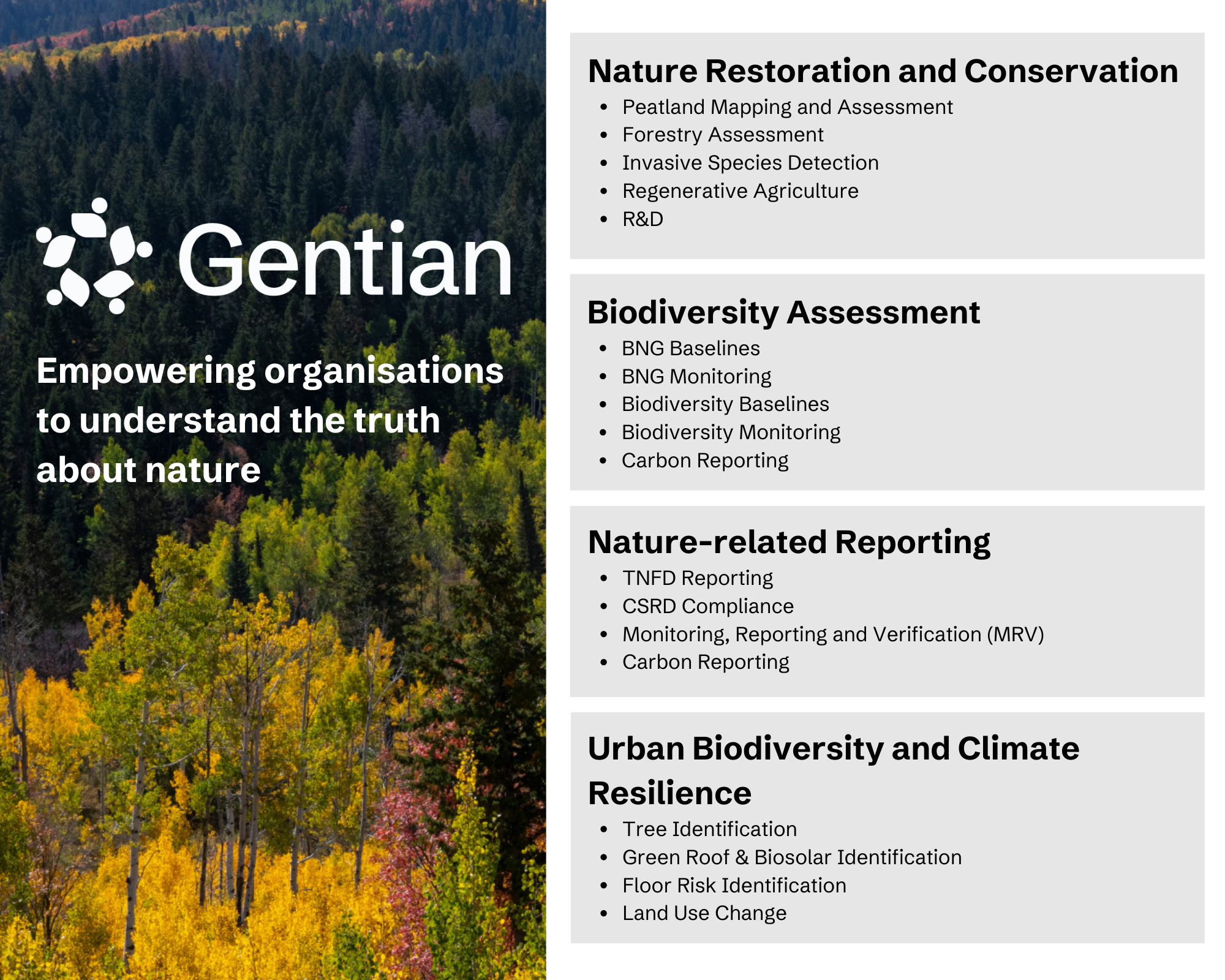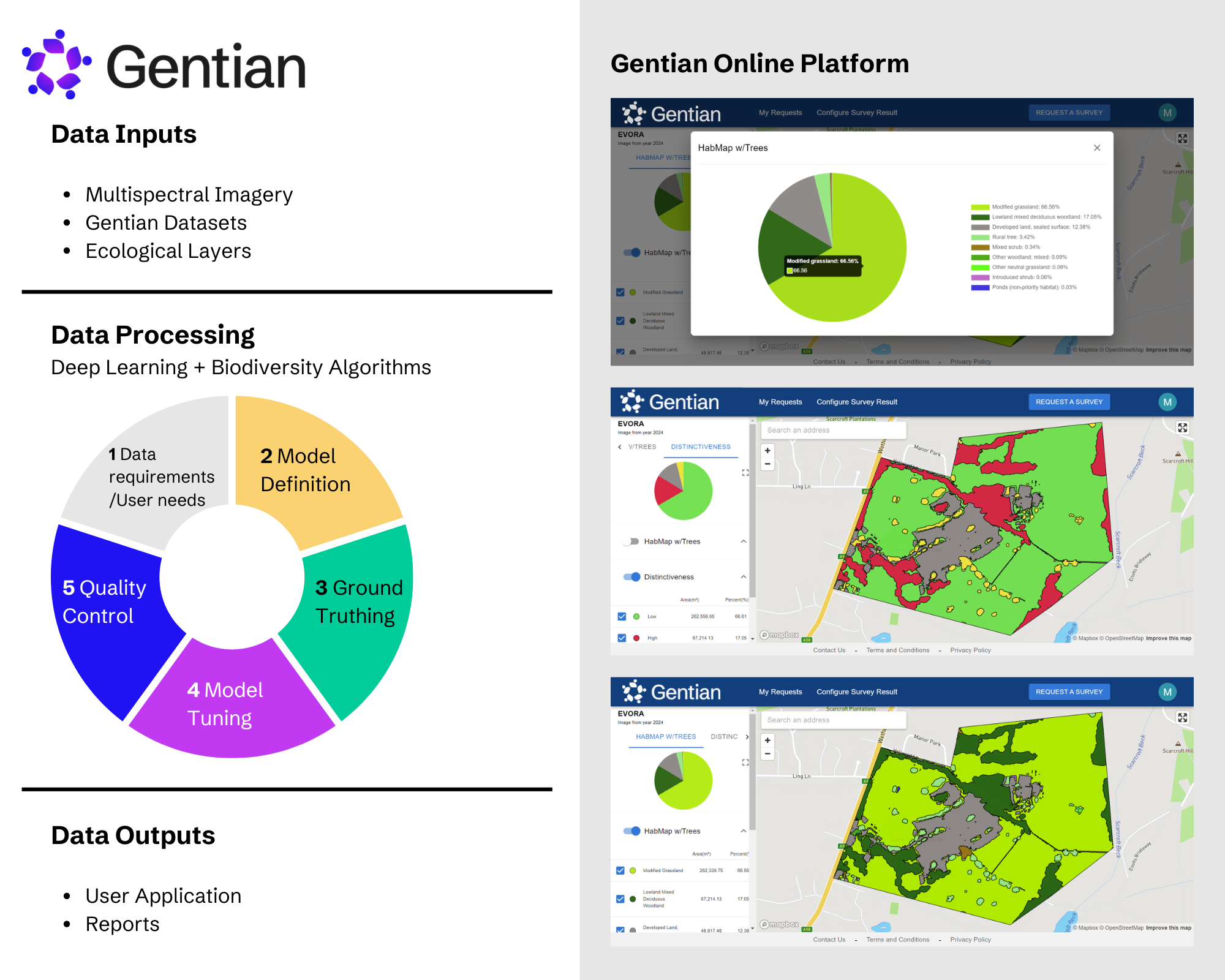
Objectives of the service

Biodiversity loss is one of the greatest challenges of our time. Businesses, governments, and organizations require timely, high-quality data to meet Global Biodiversity Framework targets, regulatory requirements, and sustainability commitments. Yet, current ecological assessment methods, including e-DNA, remain costly, inconsistent, difficult to apply for long term monitoring and difficult to scale.
Gentian combines two of the latest technologies to address this challenge by:
-
Automating ecological surveys with AI-driven habitat classification models trained on Very High Resolution satellite imagery.
-
Delivering assessments in formats aligned with biodiversity reporting frameworks and regulations such as UK Biodiversity Net Gain (BNG), the Taskforce on Nature-Related Disclosures (TNFD), and the EU Corporate Sustainability Reporting Directive (CSRD).
-
Providing rapid, scalable insights that support urban planning, corporate sustainability strategies, and biodiversity conservation initiatives.
-
Empowering decision-makers with fast, data-backed intelligence to assess nature-related risks, and opportunities.
Users and their needs
Gentian’s remote ecological surveys provide essential insights for diverse stakeholders:
Municipalities & Local Authorities
-
Require accurate, up-to-date data for green infrastructure planning, biodiversity restoration, and climate resilience strategies.
-
Benefit from Gentian’s urban assessments, including Green Roof Identification, which enables planning for sustainable urban environments.
Real Estate Owners & Developers
-
Face regulatory mandates to demonstrate net biodiversity gain on new developments.
-
Use Gentian’s remote surveys to assess baseline biodiversity, monitor change, and integrate nature-based solutions into planning.
Large Corporations & Financial Institutions
-
Require high-quality biodiversity data for ESG reporting and compliance with TNFD and CSRD frameworks.
-
Utilise Gentian’s automated habitat mapping for reporting, monitoring and verifying (MRV) nature-related risks and opportunities within their operations and supply chains.
Service/ system concept
Gentian provides an end-to-end remote ecological survey platform, delivering precision-driven biodiversity insights through an intuitive online interface.
How it Works:
-
Users define an area of interest via an interactive map.
-
Gentian’s AI-powered analysis classifies habitat types using high resolution satellite imagery.
-
Results are delivered within minutes to days (depending on the product), including interactive maps, biodiversity metrics, and GIS-ready datasets.
Key Features:
-
Automated AI-driven habitat classification aligned with global biodiversity reporting standards.
-
Integration with TNFD, BNG, and CSRD frameworks.
-
Multi-scale analysis from urban microhabitats to large-scale ecosystems.
-
Easy access to data via a web based application for visualisation and download of data and custom reporting.

Space Added Value
Gentian leverages Very High Resolution satellite imagery to provide a scalable, automated alternative to traditional ecological surveys. Unlike conventional methods, which rely on ground-based assessments, Gentian’s approach has the following advantages :
-
Global solution
-
Scalable
-
Cost effective
-
Consistent, repeatable, and objective habitat mapping (removes subjectivity)
-
Data solution for hard-to-access locations, including wetlands, peatlands, urban environments.
-
Accurate, results have been validated by customers and found to be 97% similar to manual results
-
Ideal for long term monitoring and change analysis
Current Status
Gentian has successfully completed pilot deployments and is scaling its operations to deliver commercial biodiversity monitoring solutions on a global scale.
Demonstration Project milestones included:
-
Urban biodiversity assessments completed in the UK, Europe, North America and Japan.
-
Pilot Studies completed with customers from different stakeholder groups to demonstrate the commercial viability and validate user requirements
Gentian has gained recognition by being nominated for multiple innovation awards, including the EarthPrize 2024 & 2025 and recognition as a Top 17 Global Innovator for Biodiversity by the World Economic Forum Uplink Programme in 2024.


